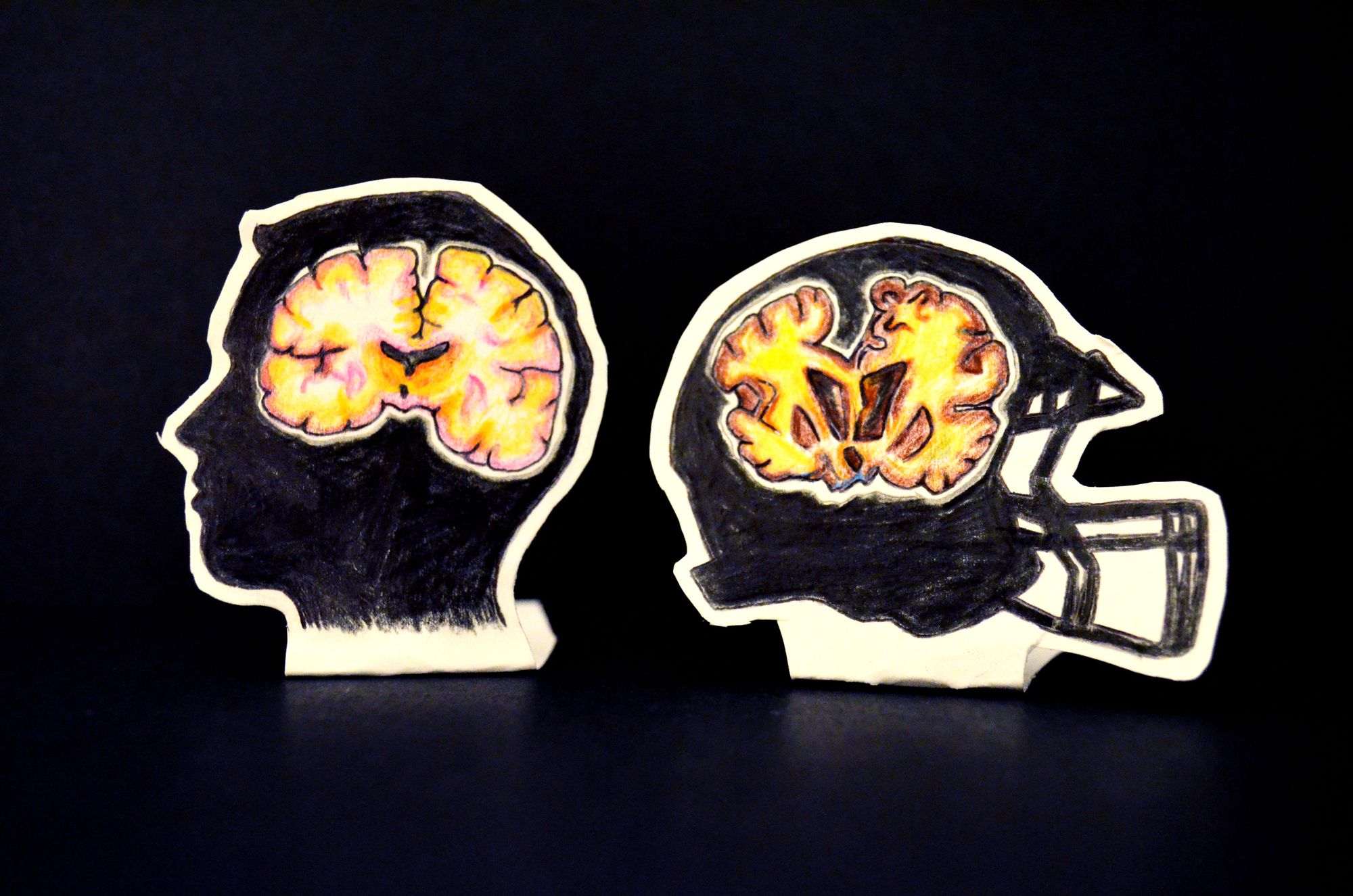Sports are expensive. From a new pair of cleats to multi-million dollar stadiums, people spend a lot of money on the games they love. Perhaps the biggest cost, however, is the health of players’ bodies and minds. Chronic Traumatic Encephalopathy (CTE) is a preventable neurodegenerative disease associated with head trauma, often stemming from contact sports such as football, boxing, soccer, and hockey. More serious than an isolated concussion, CTE arises from repeated concussions. These often lead to long-term impairments, including a loss of motor skills, memory recall issues, and difficulties with impulse control and emotional processing [1].
Formerly referred to as Dementia pugilistica, or “punch-drunk” syndrome, CTE was first observed in boxers in the 1920s. As a subset of dementia, CTE was often misdiagnosed as early-onset Alzheimer’s Disease due to an overlap in symptoms like memory loss and neural degeneration [2]. Many CTE sufferers also experience depression, social withdrawal, violent impulses, and suicidal thoughts or actions [1]. Compared to neurodegenerative diseases with similar symptoms, CTE is uniquely preventable [1]. Avoidance of activities that commonly result in head trauma greatly minimizes the risk of repeated concussions and, consequently, the risk of developing CTE.
One of the first recognized cases of CTE was a boxer who started experiencing memory loss in his mid-twenties after retiring at age 22. Later in life, he was hospitalized multiple times for aggressive behavior. He eventually could not recognize local streets or even family members. After his death, his brain showed cerebellar atrophy and enlarged ventricles, often characteristic of dementia. These observations made by medical examiners would later be recognized as signs of CTE [1].
Research into CTE began in earnest after the brains of deceased professional football players were autopsied to reveal overwhelming and consistent evidence of CTE. Chris Nowinski, former Harvard football player and boxer, ultimately brought greater notoriety and funding to the issue through his own experience with professional sports. After experiencing a number of concussions that led to his retirement from wrestling, Nowinski aggressively advocated for education and research about the effects of concussions on athletes. Together, Nowinski and Dr. Ann McKee of Boston University combined their interest in CTE to accelerate current research on the condition. As a result of their efforts, the brains of many former athletes have been donated to the Boston University research center, now the largest center for CTE research, in hopes that they will help researchers better understand CTE [4].
Currently, we recognize CTE as a unique disease and have a better understanding of its symptoms. Despite this knowledge, CTE is still only diagnosable post mortem. A defining molecular characteristic of CTE is “neurofibrillary tangles,” structures of the p-tau protein that collect around microtubules in the brain. These tangles lead to the collapse of microtubules, preventing them from performing their normal role in nutrient transport. P-tau protein buildups, which characterize CTE, are undetectable through current imaging techniques such as MRI scans, and there are no known biomarkers to indicate these protein buildups [5].
Neurons in those affected by CTE are deprived of adequate nutrition due to p-tau buildups. Because of this, the brain often experiences a loss of mass and thinning of the corpus callosum connecting the left and right halves of the brain, thus inhibiting communication between brain hemispheres. The tangles also contribute to the loss of functional neural connections in the amygdala, hippocampus, and frontal cortex. Decay in these areas is the most likely cause of issues with emotional processing, memory, and judgment [1].

When evidence first emerged in support of a correlation between participation in contact sports and CTE, the National Football League (NFL) vehemently denied the sport’s role in the degradation of a player’s quality of life, and claimed the studies surrounding CTE were unfounded [6]. When former NFL players rallied together in a lawsuit against the league, the NFL issued a monetary settlement to living players for the risk of CTE exposure [3]. Since accepting CTE as a real threat to the health of players, the NFL has donated money to research efforts on the condition at Boston University. The NFL has also amended rules regarding helmet-to-helmet contact—contact to a player’s head is now illegal, and the play is immediately ended anytime a helmet is removed. Medics specifically trained to look for head contact indicative of concussions now join the team on the sidelines [6].
Still, controversy remains. Skeptics of CTE observe that there are currently no studies comparing both sports and non-sports related head trauma. [7]. Although studies have shown CTE also appears in fervent head-bangers and military personnel, research suggests that the primary form of CTE acquisition is through sports. The issue extends beyond statistical measures, however. Much of the outcry regarding tackle football is not aimed at the NFL, but rather at youth sports leagues. Football is such a deeply ingrained part of American culture that some parents would rather deny the risks of CTE than consider removing their children or even banning tackling from the game. However, the longer we deny CTE as a threat to children’s mental health, the longer we risk their future health and well-being.
Whether it be football, boxing, or hockey, people of all ages participate in sports where concussions are nearly inevitable with current safety measures. Considering the current inability to diagnose CTE and the severity of the condition, it is worth considering ways we may be able to make contact sports less risky for everyone involved. If we care not only about the sports but also about the players, we should abandon efforts to preserve the nature of a game and instead invest in the health of our players.
References
- McKee, A. C., Cantu, R. C., Nowinski, C. J., Hedley-Whyte, E. T., Gavett, B. E., Budson, A. E., … Stern, R. A. (2009). Chronic Traumatic Encephalopathy in Athletes: Progressive Tauopathy following Repetitive Head Injury. Journal of Neuropathology and Experimental Neurology, 68(7), 709–735. http://doi.org/10.1097/NEN.0b013e3181a9d503
- Andrew Gardner, Grant L Iverson, Paul McCrory Br J Sports Med bjsports-2013-092646Published Online First: 26 June 2013 doi:10.1136/bjsports-2013-092646
- NFL, ex-players agree to $765M settlement in concussions suit. (2013, August 29). Retrieved October 18, 2015, from http://www.nfl.com/news/story/0ap1000000235494/article/nfl-explayers-agree-to-765m-settlement-in-concussions-suit
- Often Misdiagnosed as Alzheimer’s Disease, Chronic Traumatic Encephalopathy Could Play a Role in Veterans’ Dementia. (2011, May 19). Retrieved October 14, 2015, from http://www.usmedicine.com/agencies/department-of-defense-dod/often-misdiagnosed-as-alzheimers-disease-chronic-traumatic-encephalopathy-could-play-a-role-in-veterans-dementia/
- Gavett BE, Stern RA, McKee AC. Chronic Traumatic Encephalopathy: A Potential Late Effect of Sport-Related Concussive and Subconcussive Head Trauma. Clinics in sports medicine. 2011;30(1):179-xi. doi:10.1016/j.csm.2010.09.007.
- Independent concussion specialists ready to work NFL sidelines. (2013, September 3). Retrieved November 12, 2015, from http://www.nfl.com/news/story/0ap1000000237739/article/independent-concussion-specialists-ready-to-work-nfl-sidelines
- Maroon JC, Winkelman R, Bost J, Amos A, Mathyssek C, et al. (2015) Correction: Chronic Traumatic Encephalopathy in Contact Sports: A Systematic Review of All Reported Pathological Cases. PLoS ONE 10(6): e0130507. doi: 10.1371/journal.pone.0130507
